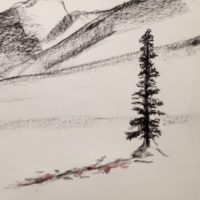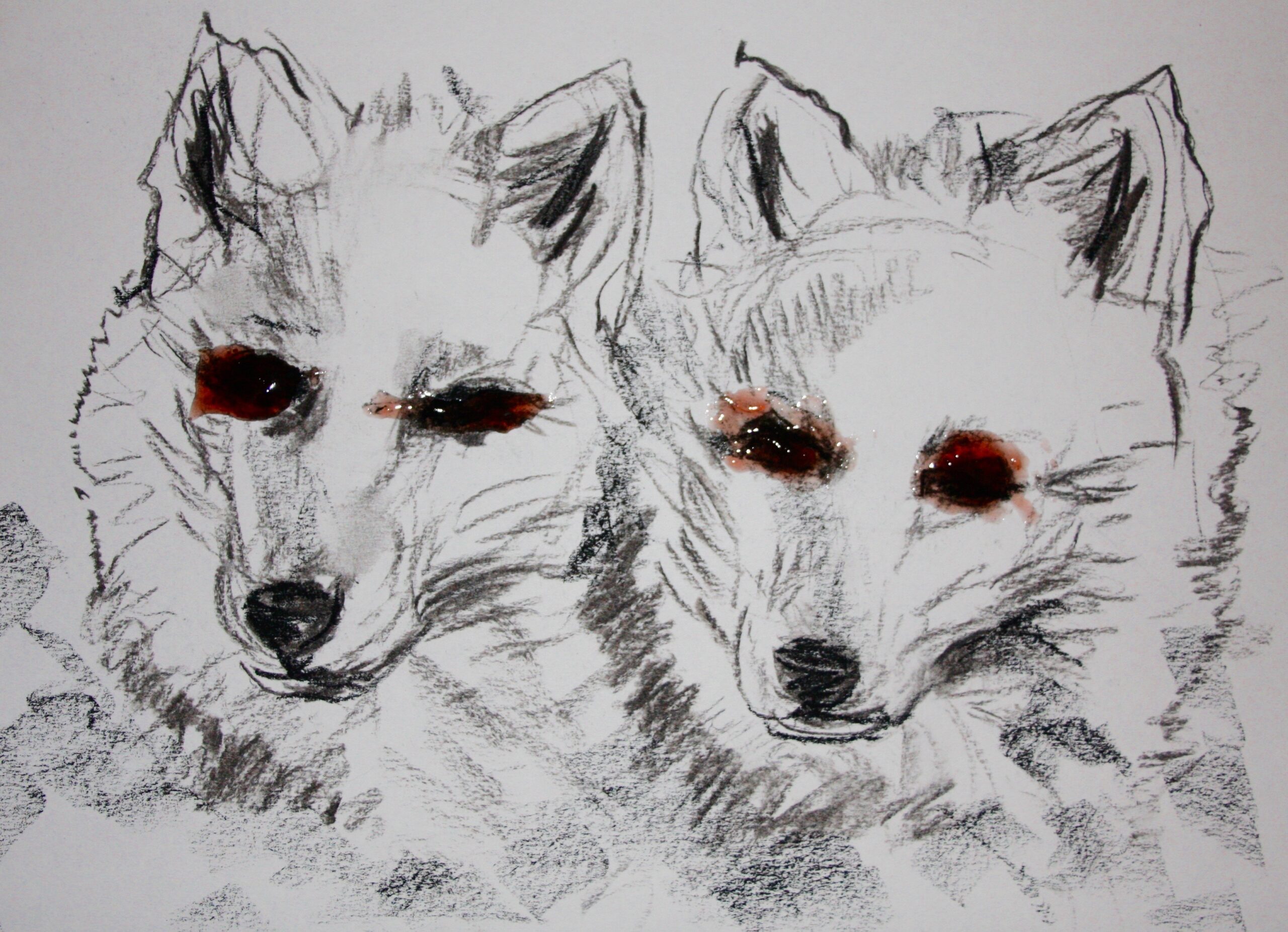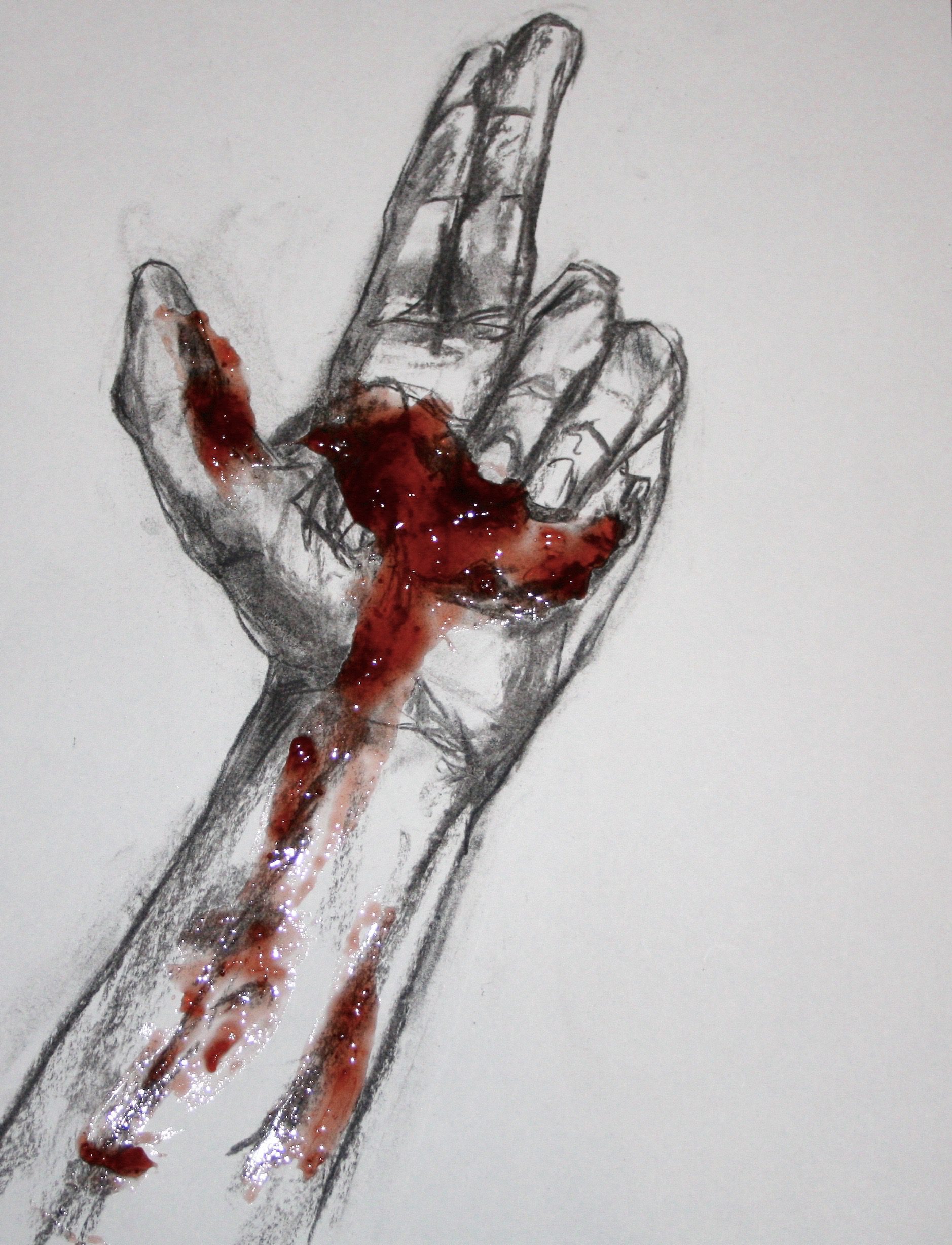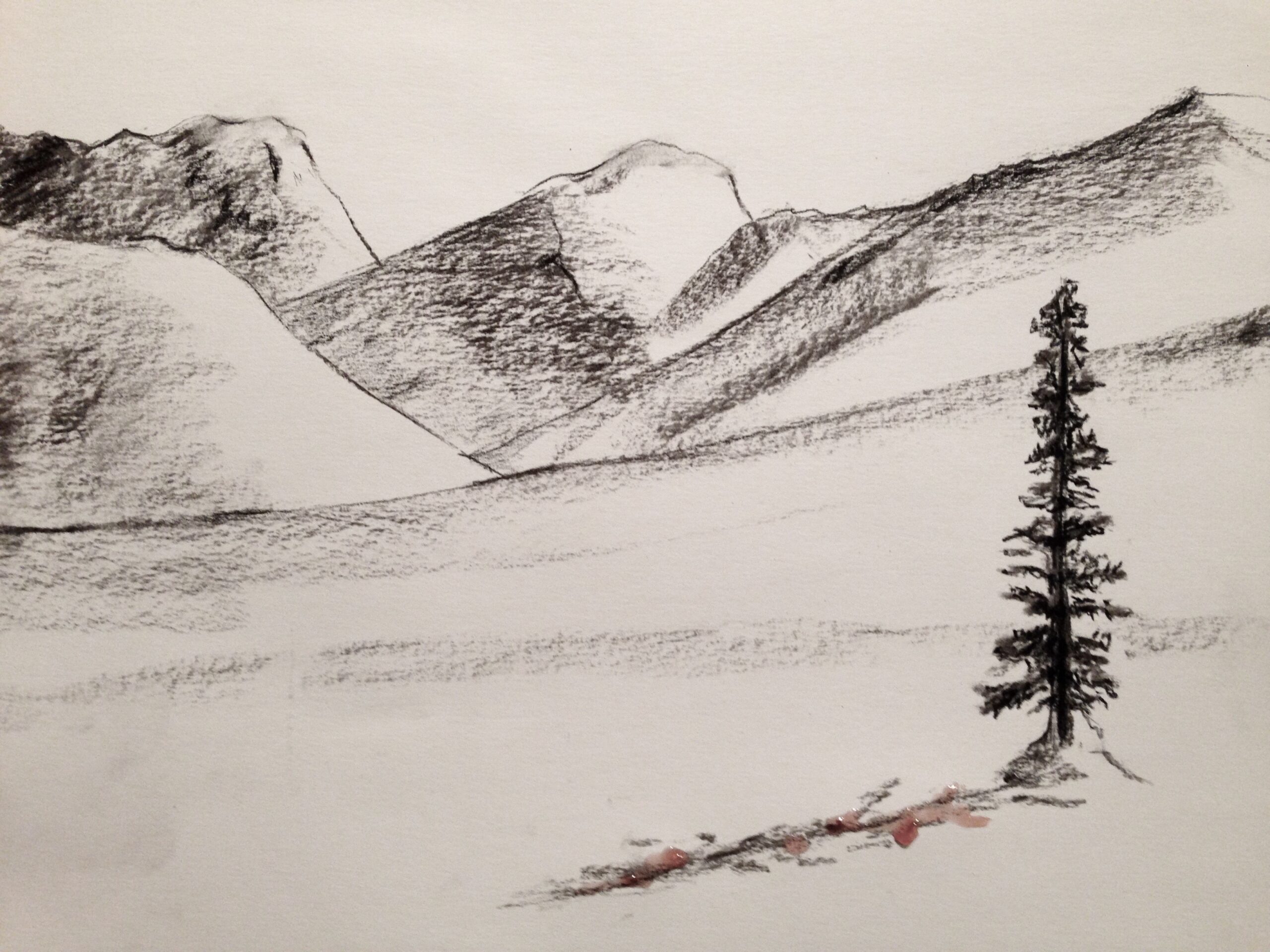I have a student, a kindergartener, who runs a trap line with her dad. She has a mini snowmobile that she rides alongside his grown-up snowmobile and points to where she wants him to set her traps on the tundra. Together, they pry open the jaws, set the bait, and cover up their traces. The traps they set are for foxes. The trap grabs a foot and holds on without breaking the skin. “They can be used for catch-and-release hunting. They don’t hurt the animal,” the dad explains to me, standing behind two very dead, very frozen foxes lying stiffly on their sides on the table at the back of my classroom.
The rainbow table, I call it. I bring small groups of students there. We play practice games and read our decodable readers with their titles like, Pal Has Ham and What Can Two Do? What can two do? I wonder as we turn the pages of two girls in a sandbox. It’s been so long I hardly remember what sweet, messy things one person can do with another.
My students line up to touch the foxes, their fur unfathomably white and deep and soft. Their small black noses so perfectly shaped, their teeth white and curved and useless now, in death. I will touch, I won’t touch, I will, cautiously reaching my hand forward. The fur is luscious but feels too cold, weirdly cold, and I pull my hand back, walking quickly to the sink, pushing to the front of the line to wash the coldness of that death from my hands.
I wander back again to supervise the process. “Look,” a small voice calls. I look. Warming in the heat of my classroom and under the small, hot hands of my curious students, the foxes begin to thaw. Little puddles of blood form beneath their mouths. The place where there should be an eye there is just frozen red pulp; blood drips from that place, too. I try not to think about that eye, not to picture what force drove that eye from the small, perfect skull of the small, perfect animal beginning to warm and bleed on my rainbow table.
“These foxes offered themselves,” the dad explains. “We respect them.” I smile and nod and explain that I am so glad that he could come with these frozen foxes and their warming, bleeding bodies. We clap for the girl and her father, for respecting the foxes, for accepting their offering, and for the work they do to uphold their cultural heritage. Cultural heritage is a lot of work.
I imagine my students reading a new story at the rainbow table, one that perhaps I will write in honor of this day.
“The fox is cold.” Turn the page.
“The fox gets warm.” Turn the page.
“The fox bleeds.” The end.
We can call the story “The Fox.”
Three years ago, we were running late to school, scrambling through the pebbled ground and fighting through that constant, relentless wind. It was my first year in Alaska, a lifetime ago, in a village far from where I am now. I was teaching second grade, and he was teaching English to high school students. Another teacher rode up on one of the red, school-provided four wheelers and offered us a ride. Despite the frigid, mile-long battle against the wind I usually prefer to walk. The politics surrounding those two red four wheelers are deep-rooted and complicated.
This day, I was pregnant and tired and running late and we took the ride.
The past few days I had been bleeding. I smelled the blood that pooled in the thick pads that I wore between my thighs obsessively. I would take little sniffs, taking in the first, immediate pungent overtones and then the more subtle, layered notes beneath. It always smelled the same. It smelled like death.
We hopped on the back of the four wheeler and held on tightly as we fought our way through the wind to the school building. We bounced our way there, and as we neared the front steps, I felt something deep inside me give way. It wasn’t violent, it wasn’t painful; it was like peeling off the last little bit of an old Band Aid. The adhesive is weakened from time and sweat, and it puts up no resistance at all to that final tug. It just comes away. That’s what it felt like.
I walked inside the building and went to my classroom. I took off my snow pants and my parka and my mittens and my boots and my hat and goggles and my wool socks. So many carefully constructed layers of protection. I could feel the heavy wetness between my legs. The faster my heart beat, the more deliberately I moved.
I spent a small forever walking down the hall from my classroom to the teacher’s workroom where there was a private bathroom. I stepped inside and both knowing and not knowing, I pulled down my underwear. The thick overnight pad was already soaked in blood. Blood streamed from my body when I sat down, gingerly on the toilet seat. That warm smell of death filled the small bathroom. My body cramped, and I could feel pressure of something building up inside. Almost like your body’s natural movements when you take a shit, but this was my vagina, clenching and releasing and feeling full and feeling pressure from somewhere up and deep inside me.
Blood clots streamed one after another into the toilet and each one brought a sense of relief. A small lessening of the pressure. The blood clots were followed by three fist-sized spheres that felt like Jell-O being squeezed from my vagina. My body registered sensations; my brain registered only fear. I don’t remember thinking of this stinking bloody mess as my baby. It was a stinking bloody mess in a toilet and, reflexively, I reached back for the toilet handle and flushed it all away. Erase. Do-over. Try again next time.
I sat there, still bleeding. Knowing that class was about to begin. I put a fresh overnight size pad into my underwear, and cleaned up as well as I could. I worried that everyone would be able to smell the lingering odor of death on me. Blood was already filling the new pad between my legs. How can I teach with all this blood? I worried.
No one knew I was pregnant. He knew, of course. And my principal knew because I had requested time off to get an abortion in Anchorage. An abortion that was scheduled for Saturday morning, two days away. Both of us were booked on the flight right after school to give us some wiggle room in case the weather turned. We had prepared for weather, but we hadn’t known to prepare for this.
No one else knew. Not my friends, not my family. Why have them worry? I told myself. They were already concerned that I had left my warm, sunny haven for a cold, dark, faraway land with different foods and language and traditions. It will be fine, I had told them. It will be an adventure. I was in love. Love is an eternal optimist.
I walked back to my classroom. The bell rang and I stood silently before my second grade students. I was full of blood. I was frozen, terrified that the wrong step would send rivers of blood flowing down my thighs. Trying to smile at them reassuringly, I walked stiff-legged to the door and flagged down a passing teacher. I have to go, I said. Please stay with them.
She must have seen the desperation in my face. She nodded, stepped inside, and I hobbled my way to my principal’s office.
“I have to go home,” I told her. “I’m bleeding.”
“Right now?”
I had a miscarriage in the bathroom, I tried to explain. She reluctantly nodded. I walked home a mile in the cold and the wind, still bleeding. I got in the shower and washed my body, watching as the blood flowed down my legs and swirled in the stream and trailed down the length of the tub to wash away in the drain. I stood there, wrinkling and pruning and bleeding. He came home at lunch to check on me. I was pale and motionless on the couch. He kissed me on the forehead and left again.
That night, we got on the plane first to Nome and then to Anchorage. I remember we had a beer, which was exciting because we lived in a dry village, no alcohol could be brewed or brought into the community. This was a vacation.
I spent the next day bleeding. How could there still be so much blood?
Saturday morning, we went to the clinic. When my name was called, he sat in the waiting area, and I was led, alone, through the door and into the examination room. I took off my clothes including my underwear with yet another blood-soaked overnight pad and put on the crinkly paper gown. I was embarrassed by the blood and the smell. I made myself small and quiet because I was afraid. A nurse came in and I spread my legs for her. She inserted a long wand into my vagina. Looking at her screen, she told me that there was not an “intact fetus” inside me.
For the first time in weeks I felt hopeful. I allowed myself to think that these lovely doctors and nurses would send me away with a sticker or a pencil or some other toy from the treasure chest, and I would be free to leave and go to the pizza place with the really good IPA. I allowed myself to hope that I could leave without having the planned procedure. So much trauma had already happened inside me in such tender places. I asked my nurse, daring to lift my eyes to her eyes, “Can I go home then?”
She looked at me, surprised and said, “No. There is fetal tissue still inside that needs to be removed.”
First the first time since I had started bleeding, I cried. Sobbing in my paper gown, I asked, “Are you sure?”
The nurse was surprised and awkward in her response. Isn’t this why I had come? Why was I crying?
“Can he come in?” I sobbed. “Will you bring him to me?”
He had been waiting for me, they went and got him, and I cried in his arms, and he told me it would be okay. He said he would stay. He would stay through everything.
He came with me as I got prepped and took the pain medications. He held my hand and let me squeeze as hard as I could when they put needle inside me. He gently teased me when I was loopy and silly from the pills. I just looked into his eyes during the rest of it. I felt no pain. I felt safe and cared for. We can try again when we’re ready, he promised.
But Alaska is a hard place to live. Our love was a frail thing, weak. It couldn’t survive the wild, and like our baby, it died. Three years later, I am teaching in yet another Alaskan village, witnessing another kind of death.
A few days after my student’s father visited our classroom with the two foxes, I see him in the hallway at the end of the day. “I want to show you something,” he says, holding out his phone. “This is the video of when we first saw the foxes in her traps.” Watching the video on the tiny screen of his phone, I hear the crunching of the snow as the girl and her father walk out to check on the traps.
“I see something,” I hear a high, excited voice cry. “I see something!”
We pan over and see two foxes snarling and pulling at their feet, scrambling on the snow, trying to run. I look in the eyes, the intact eyes, of those foxes, and I try to see the offering. But I don’t. I don’t see it. I look into those eyes and I see fear. I see death. Given the opportunity, I wonder if those foxes would be willing to gnaw off the foot holding them in that trap.
This place has teeth, I realize, watching the last few moments of the lives of the two foxes. When I leave Alaska, I’ll be leaving pieces of myself behind. I imagine the bloody pieces of my own flesh still warm in the snow. I look at the ravaged part of me still left and wonder what more will I have to sacrifice.
***
Rumpus original art by Clare Nauman.







